BUSN20016 Research Proposal: Hospitality Job Evaluation Impact
VerifiedAdded on 2022/08/15
|19
|4078
|15
Project
AI Summary
This research proposal investigates the evaluation of job performance within the hospitality industry, aiming to identify factors influencing employee skills and knowledge. The introduction outlines the research problem, objectives, and questions, emphasizing the need for effective performance evaluation programs in a competitive market. A literature review explores existing research on job evaluation, its history, and its impact on employee development. The methodology section details the research philosophy, approach, data sources, and ethical considerations, including a project budget and schedule. The proposal examines barriers to effective performance evaluation, such as lack of knowledge, psychological blocks, and technological pitfalls, while also discussing various performance appraisal approaches like Management by Objective (MBO) and 360-degree feedback. The aim is to introduce effective performance evaluation tools that can enhance employee skills and contribute to organizational efficiency and customer satisfaction.
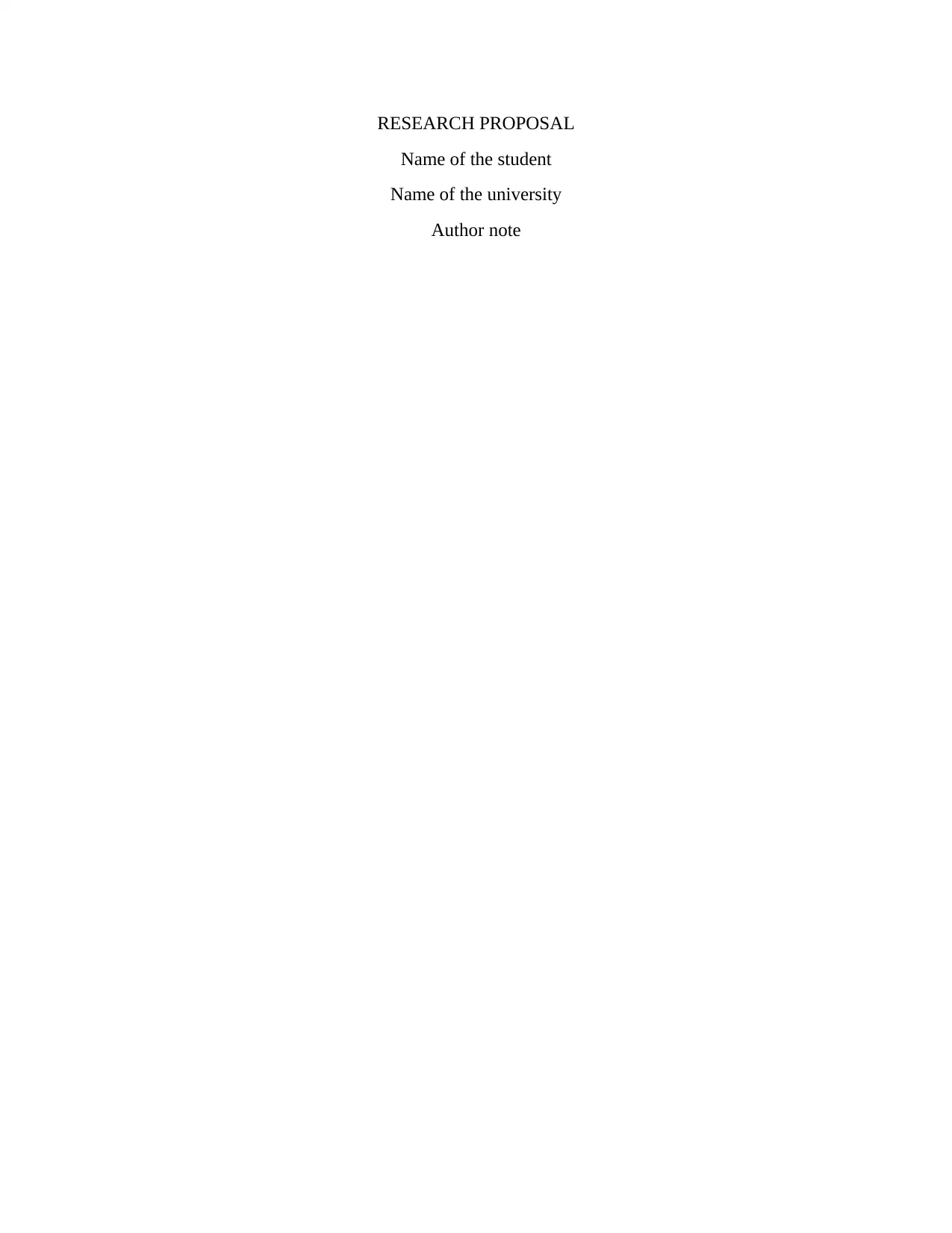
RESEARCH PROPOSAL
Name of the student
Name of the university
Author note
Name of the student
Name of the university
Author note
Paraphrase This Document
Need a fresh take? Get an instant paraphrase of this document with our AI Paraphraser
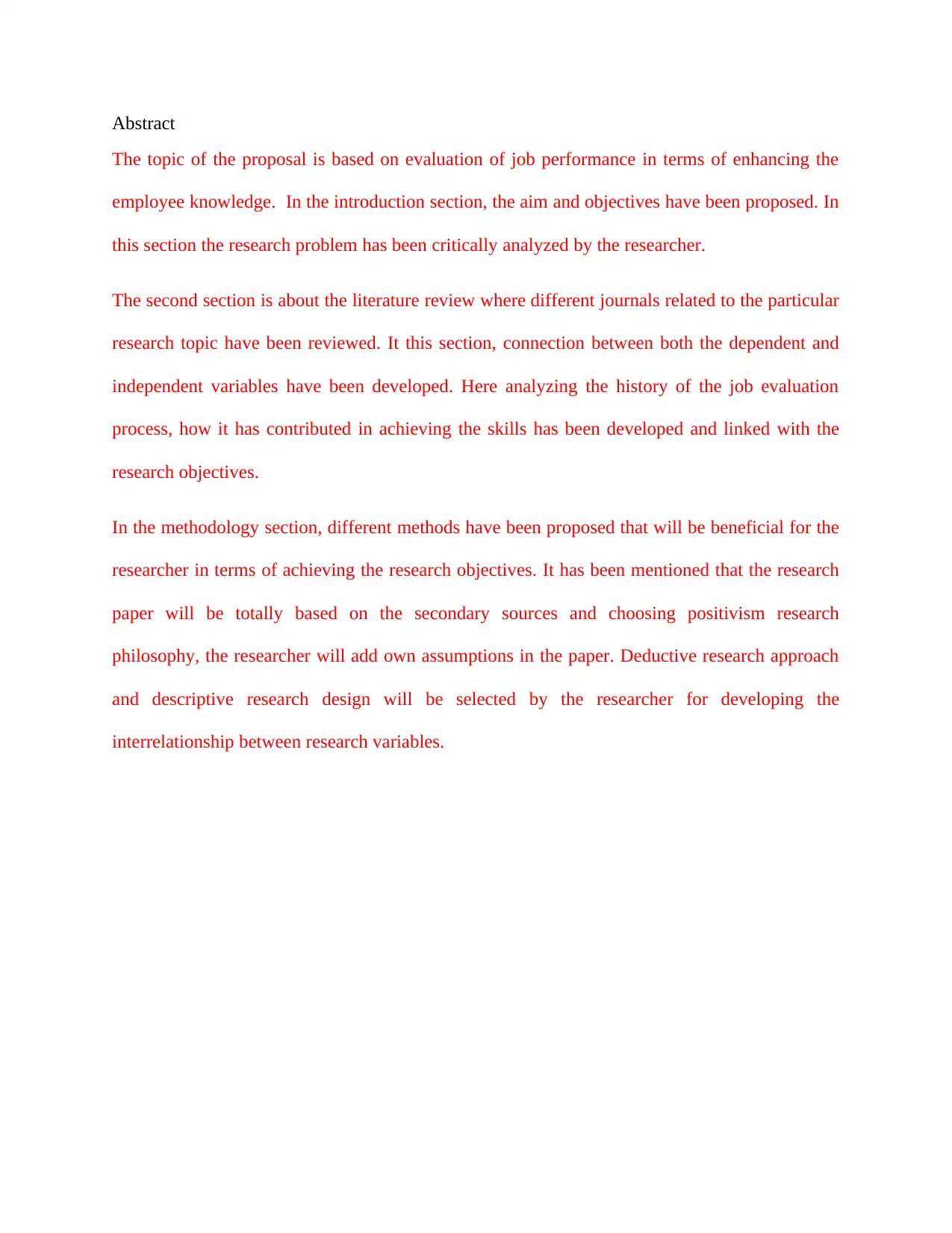
Abstract
The topic of the proposal is based on evaluation of job performance in terms of enhancing the
employee knowledge. In the introduction section, the aim and objectives have been proposed. In
this section the research problem has been critically analyzed by the researcher.
The second section is about the literature review where different journals related to the particular
research topic have been reviewed. It this section, connection between both the dependent and
independent variables have been developed. Here analyzing the history of the job evaluation
process, how it has contributed in achieving the skills has been developed and linked with the
research objectives.
In the methodology section, different methods have been proposed that will be beneficial for the
researcher in terms of achieving the research objectives. It has been mentioned that the research
paper will be totally based on the secondary sources and choosing positivism research
philosophy, the researcher will add own assumptions in the paper. Deductive research approach
and descriptive research design will be selected by the researcher for developing the
interrelationship between research variables.
The topic of the proposal is based on evaluation of job performance in terms of enhancing the
employee knowledge. In the introduction section, the aim and objectives have been proposed. In
this section the research problem has been critically analyzed by the researcher.
The second section is about the literature review where different journals related to the particular
research topic have been reviewed. It this section, connection between both the dependent and
independent variables have been developed. Here analyzing the history of the job evaluation
process, how it has contributed in achieving the skills has been developed and linked with the
research objectives.
In the methodology section, different methods have been proposed that will be beneficial for the
researcher in terms of achieving the research objectives. It has been mentioned that the research
paper will be totally based on the secondary sources and choosing positivism research
philosophy, the researcher will add own assumptions in the paper. Deductive research approach
and descriptive research design will be selected by the researcher for developing the
interrelationship between research variables.
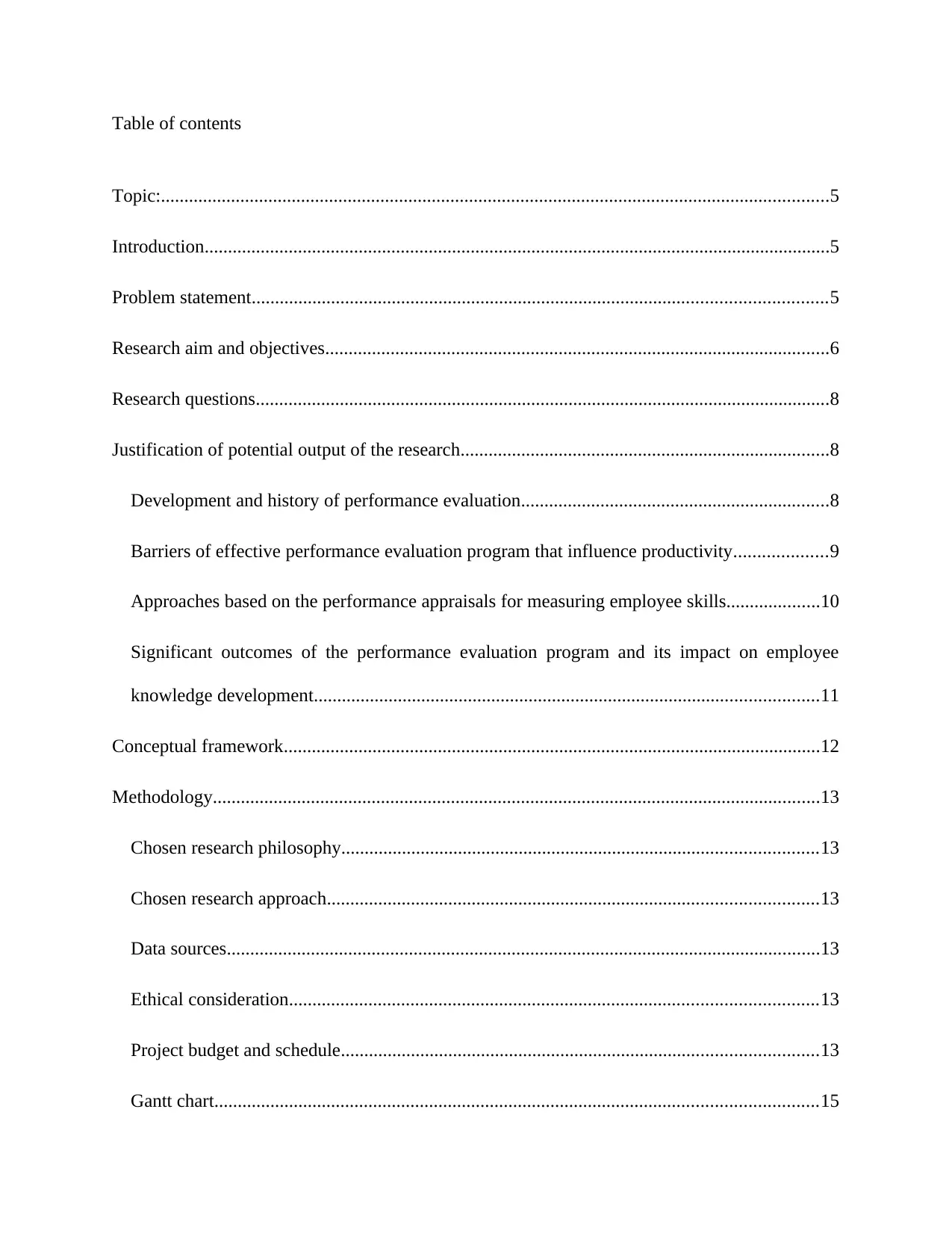
Table of contents
Topic:...............................................................................................................................................5
Introduction......................................................................................................................................5
Problem statement...........................................................................................................................5
Research aim and objectives............................................................................................................6
Research questions...........................................................................................................................8
Justification of potential output of the research...............................................................................8
Development and history of performance evaluation..................................................................8
Barriers of effective performance evaluation program that influence productivity....................9
Approaches based on the performance appraisals for measuring employee skills....................10
Significant outcomes of the performance evaluation program and its impact on employee
knowledge development............................................................................................................11
Conceptual framework...................................................................................................................12
Methodology..................................................................................................................................13
Chosen research philosophy......................................................................................................13
Chosen research approach.........................................................................................................13
Data sources...............................................................................................................................13
Ethical consideration.................................................................................................................13
Project budget and schedule......................................................................................................13
Gantt chart.................................................................................................................................15
Topic:...............................................................................................................................................5
Introduction......................................................................................................................................5
Problem statement...........................................................................................................................5
Research aim and objectives............................................................................................................6
Research questions...........................................................................................................................8
Justification of potential output of the research...............................................................................8
Development and history of performance evaluation..................................................................8
Barriers of effective performance evaluation program that influence productivity....................9
Approaches based on the performance appraisals for measuring employee skills....................10
Significant outcomes of the performance evaluation program and its impact on employee
knowledge development............................................................................................................11
Conceptual framework...................................................................................................................12
Methodology..................................................................................................................................13
Chosen research philosophy......................................................................................................13
Chosen research approach.........................................................................................................13
Data sources...............................................................................................................................13
Ethical consideration.................................................................................................................13
Project budget and schedule......................................................................................................13
Gantt chart.................................................................................................................................15
⊘ This is a preview!⊘
Do you want full access?
Subscribe today to unlock all pages.

Trusted by 1+ million students worldwide
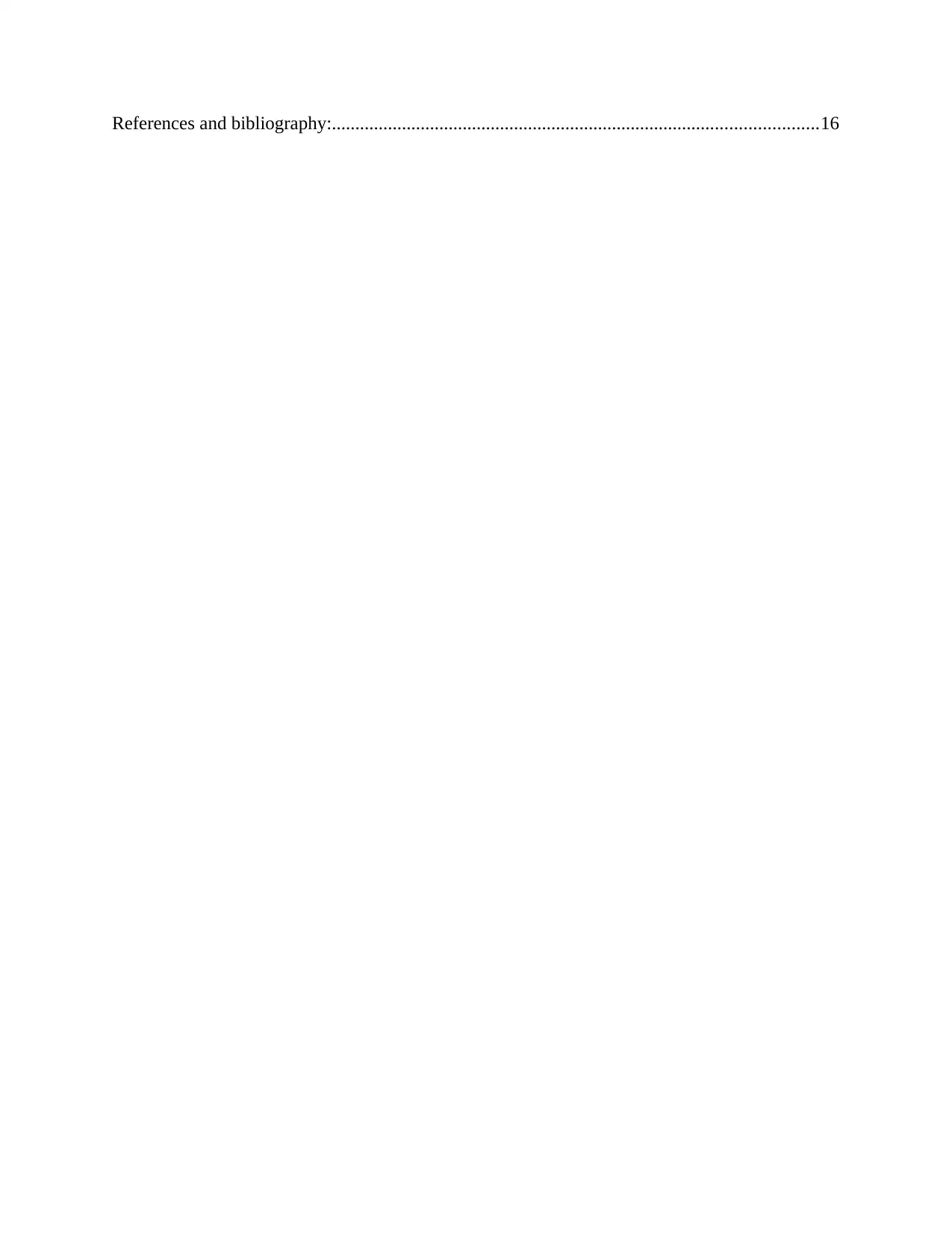
References and bibliography:........................................................................................................16
Paraphrase This Document
Need a fresh take? Get an instant paraphrase of this document with our AI Paraphraser
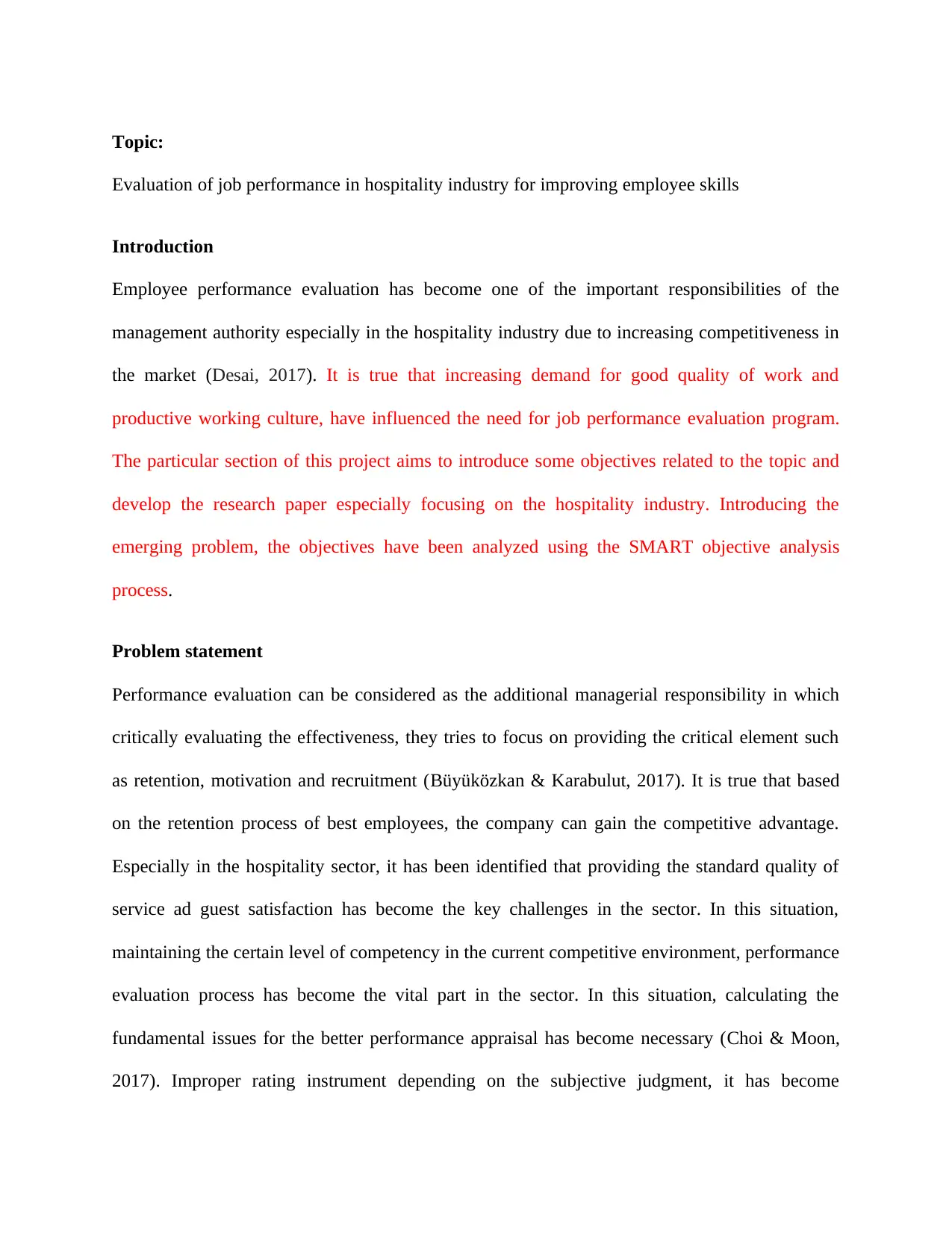
Topic:
Evaluation of job performance in hospitality industry for improving employee skills
Introduction
Employee performance evaluation has become one of the important responsibilities of the
management authority especially in the hospitality industry due to increasing competitiveness in
the market (Desai, 2017). It is true that increasing demand for good quality of work and
productive working culture, have influenced the need for job performance evaluation program.
The particular section of this project aims to introduce some objectives related to the topic and
develop the research paper especially focusing on the hospitality industry. Introducing the
emerging problem, the objectives have been analyzed using the SMART objective analysis
process.
Problem statement
Performance evaluation can be considered as the additional managerial responsibility in which
critically evaluating the effectiveness, they tries to focus on providing the critical element such
as retention, motivation and recruitment (Büyüközkan & Karabulut, 2017). It is true that based
on the retention process of best employees, the company can gain the competitive advantage.
Especially in the hospitality sector, it has been identified that providing the standard quality of
service ad guest satisfaction has become the key challenges in the sector. In this situation,
maintaining the certain level of competency in the current competitive environment, performance
evaluation process has become the vital part in the sector. In this situation, calculating the
fundamental issues for the better performance appraisal has become necessary (Choi & Moon,
2017). Improper rating instrument depending on the subjective judgment, it has become
Evaluation of job performance in hospitality industry for improving employee skills
Introduction
Employee performance evaluation has become one of the important responsibilities of the
management authority especially in the hospitality industry due to increasing competitiveness in
the market (Desai, 2017). It is true that increasing demand for good quality of work and
productive working culture, have influenced the need for job performance evaluation program.
The particular section of this project aims to introduce some objectives related to the topic and
develop the research paper especially focusing on the hospitality industry. Introducing the
emerging problem, the objectives have been analyzed using the SMART objective analysis
process.
Problem statement
Performance evaluation can be considered as the additional managerial responsibility in which
critically evaluating the effectiveness, they tries to focus on providing the critical element such
as retention, motivation and recruitment (Büyüközkan & Karabulut, 2017). It is true that based
on the retention process of best employees, the company can gain the competitive advantage.
Especially in the hospitality sector, it has been identified that providing the standard quality of
service ad guest satisfaction has become the key challenges in the sector. In this situation,
maintaining the certain level of competency in the current competitive environment, performance
evaluation process has become the vital part in the sector. In this situation, calculating the
fundamental issues for the better performance appraisal has become necessary (Choi & Moon,
2017). Improper rating instrument depending on the subjective judgment, it has become
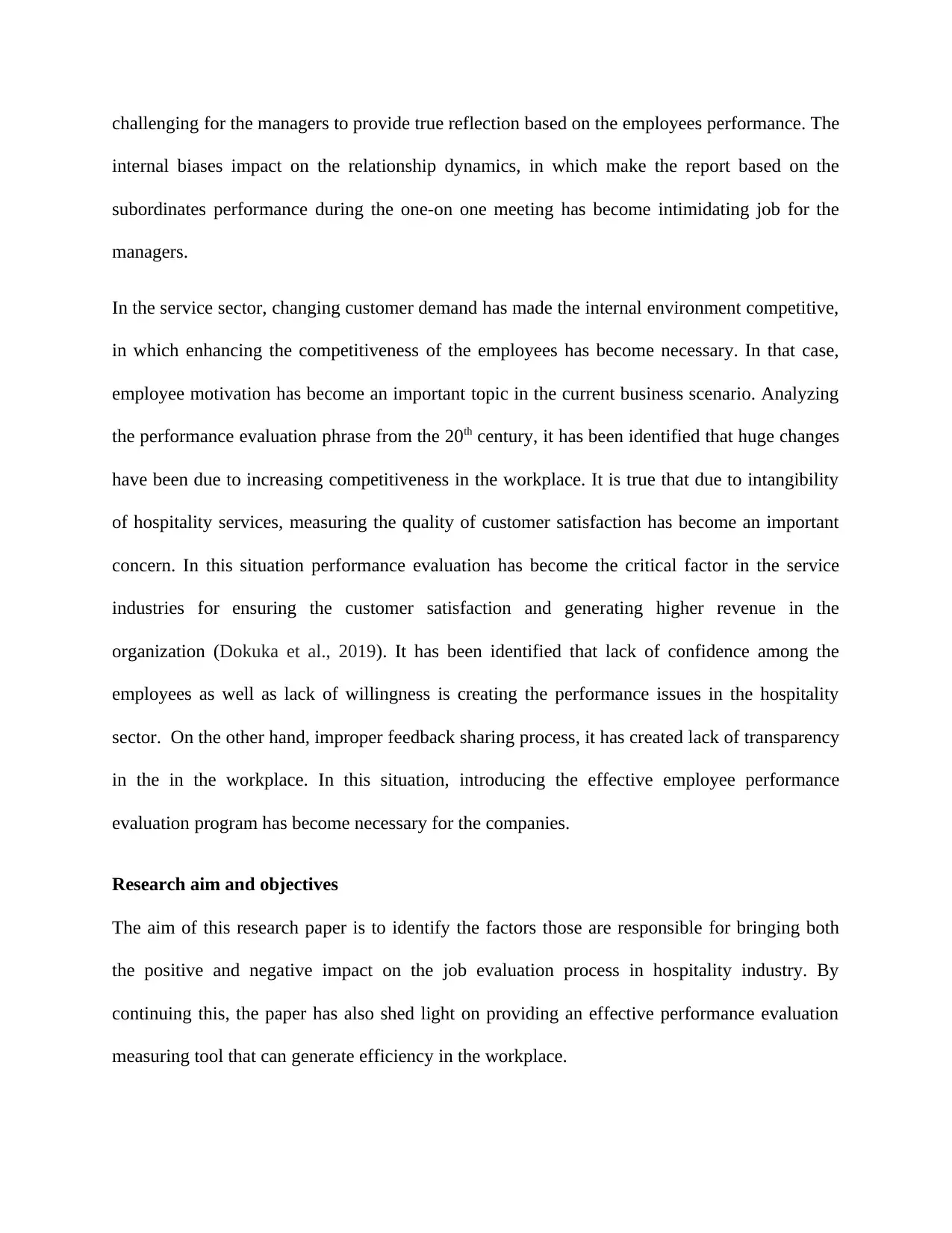
challenging for the managers to provide true reflection based on the employees performance. The
internal biases impact on the relationship dynamics, in which make the report based on the
subordinates performance during the one-on one meeting has become intimidating job for the
managers.
In the service sector, changing customer demand has made the internal environment competitive,
in which enhancing the competitiveness of the employees has become necessary. In that case,
employee motivation has become an important topic in the current business scenario. Analyzing
the performance evaluation phrase from the 20th century, it has been identified that huge changes
have been due to increasing competitiveness in the workplace. It is true that due to intangibility
of hospitality services, measuring the quality of customer satisfaction has become an important
concern. In this situation performance evaluation has become the critical factor in the service
industries for ensuring the customer satisfaction and generating higher revenue in the
organization (Dokuka et al., 2019). It has been identified that lack of confidence among the
employees as well as lack of willingness is creating the performance issues in the hospitality
sector. On the other hand, improper feedback sharing process, it has created lack of transparency
in the in the workplace. In this situation, introducing the effective employee performance
evaluation program has become necessary for the companies.
Research aim and objectives
The aim of this research paper is to identify the factors those are responsible for bringing both
the positive and negative impact on the job evaluation process in hospitality industry. By
continuing this, the paper has also shed light on providing an effective performance evaluation
measuring tool that can generate efficiency in the workplace.
internal biases impact on the relationship dynamics, in which make the report based on the
subordinates performance during the one-on one meeting has become intimidating job for the
managers.
In the service sector, changing customer demand has made the internal environment competitive,
in which enhancing the competitiveness of the employees has become necessary. In that case,
employee motivation has become an important topic in the current business scenario. Analyzing
the performance evaluation phrase from the 20th century, it has been identified that huge changes
have been due to increasing competitiveness in the workplace. It is true that due to intangibility
of hospitality services, measuring the quality of customer satisfaction has become an important
concern. In this situation performance evaluation has become the critical factor in the service
industries for ensuring the customer satisfaction and generating higher revenue in the
organization (Dokuka et al., 2019). It has been identified that lack of confidence among the
employees as well as lack of willingness is creating the performance issues in the hospitality
sector. On the other hand, improper feedback sharing process, it has created lack of transparency
in the in the workplace. In this situation, introducing the effective employee performance
evaluation program has become necessary for the companies.
Research aim and objectives
The aim of this research paper is to identify the factors those are responsible for bringing both
the positive and negative impact on the job evaluation process in hospitality industry. By
continuing this, the paper has also shed light on providing an effective performance evaluation
measuring tool that can generate efficiency in the workplace.
⊘ This is a preview!⊘
Do you want full access?
Subscribe today to unlock all pages.

Trusted by 1+ million students worldwide
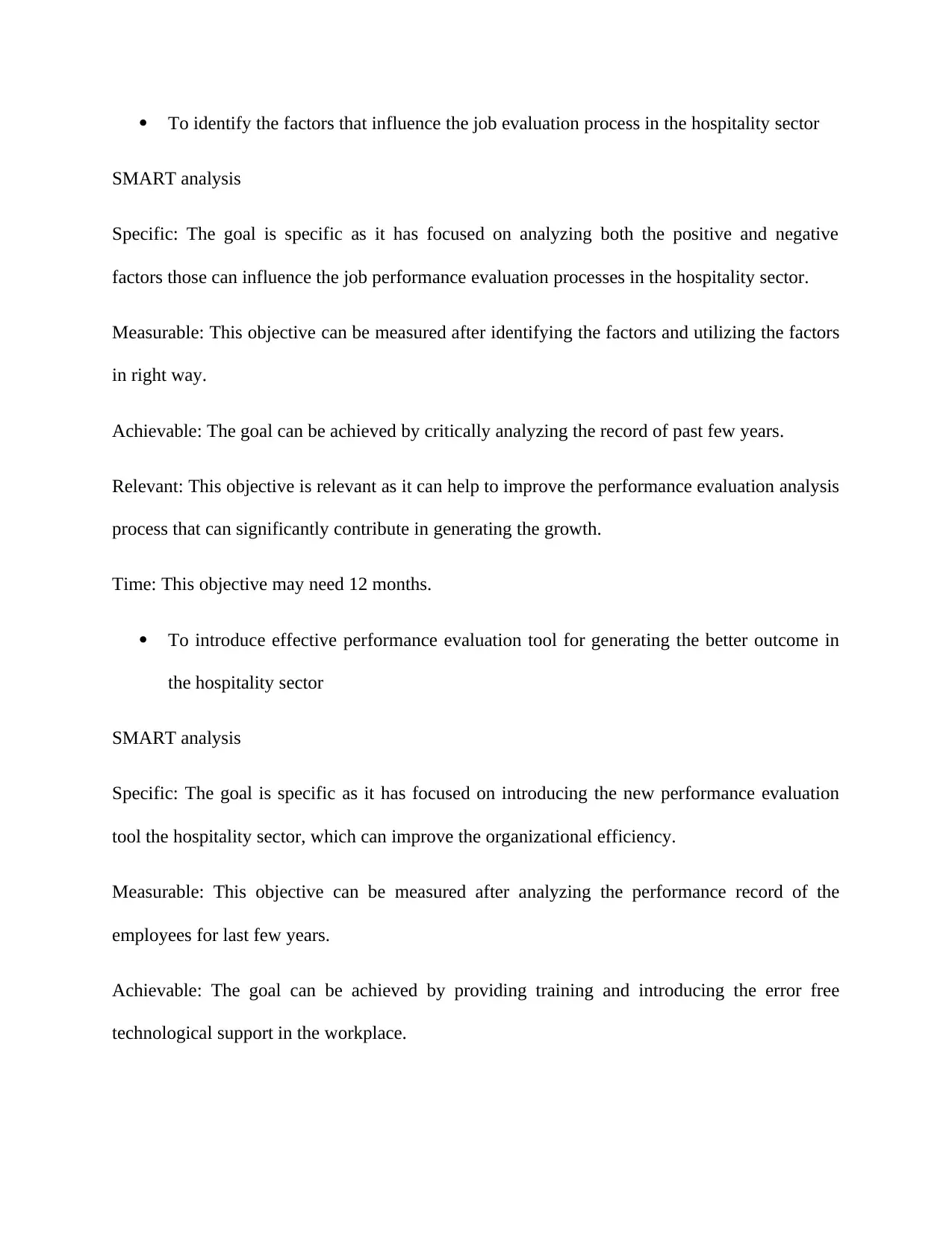
To identify the factors that influence the job evaluation process in the hospitality sector
SMART analysis
Specific: The goal is specific as it has focused on analyzing both the positive and negative
factors those can influence the job performance evaluation processes in the hospitality sector.
Measurable: This objective can be measured after identifying the factors and utilizing the factors
in right way.
Achievable: The goal can be achieved by critically analyzing the record of past few years.
Relevant: This objective is relevant as it can help to improve the performance evaluation analysis
process that can significantly contribute in generating the growth.
Time: This objective may need 12 months.
To introduce effective performance evaluation tool for generating the better outcome in
the hospitality sector
SMART analysis
Specific: The goal is specific as it has focused on introducing the new performance evaluation
tool the hospitality sector, which can improve the organizational efficiency.
Measurable: This objective can be measured after analyzing the performance record of the
employees for last few years.
Achievable: The goal can be achieved by providing training and introducing the error free
technological support in the workplace.
SMART analysis
Specific: The goal is specific as it has focused on analyzing both the positive and negative
factors those can influence the job performance evaluation processes in the hospitality sector.
Measurable: This objective can be measured after identifying the factors and utilizing the factors
in right way.
Achievable: The goal can be achieved by critically analyzing the record of past few years.
Relevant: This objective is relevant as it can help to improve the performance evaluation analysis
process that can significantly contribute in generating the growth.
Time: This objective may need 12 months.
To introduce effective performance evaluation tool for generating the better outcome in
the hospitality sector
SMART analysis
Specific: The goal is specific as it has focused on introducing the new performance evaluation
tool the hospitality sector, which can improve the organizational efficiency.
Measurable: This objective can be measured after analyzing the performance record of the
employees for last few years.
Achievable: The goal can be achieved by providing training and introducing the error free
technological support in the workplace.
Paraphrase This Document
Need a fresh take? Get an instant paraphrase of this document with our AI Paraphraser
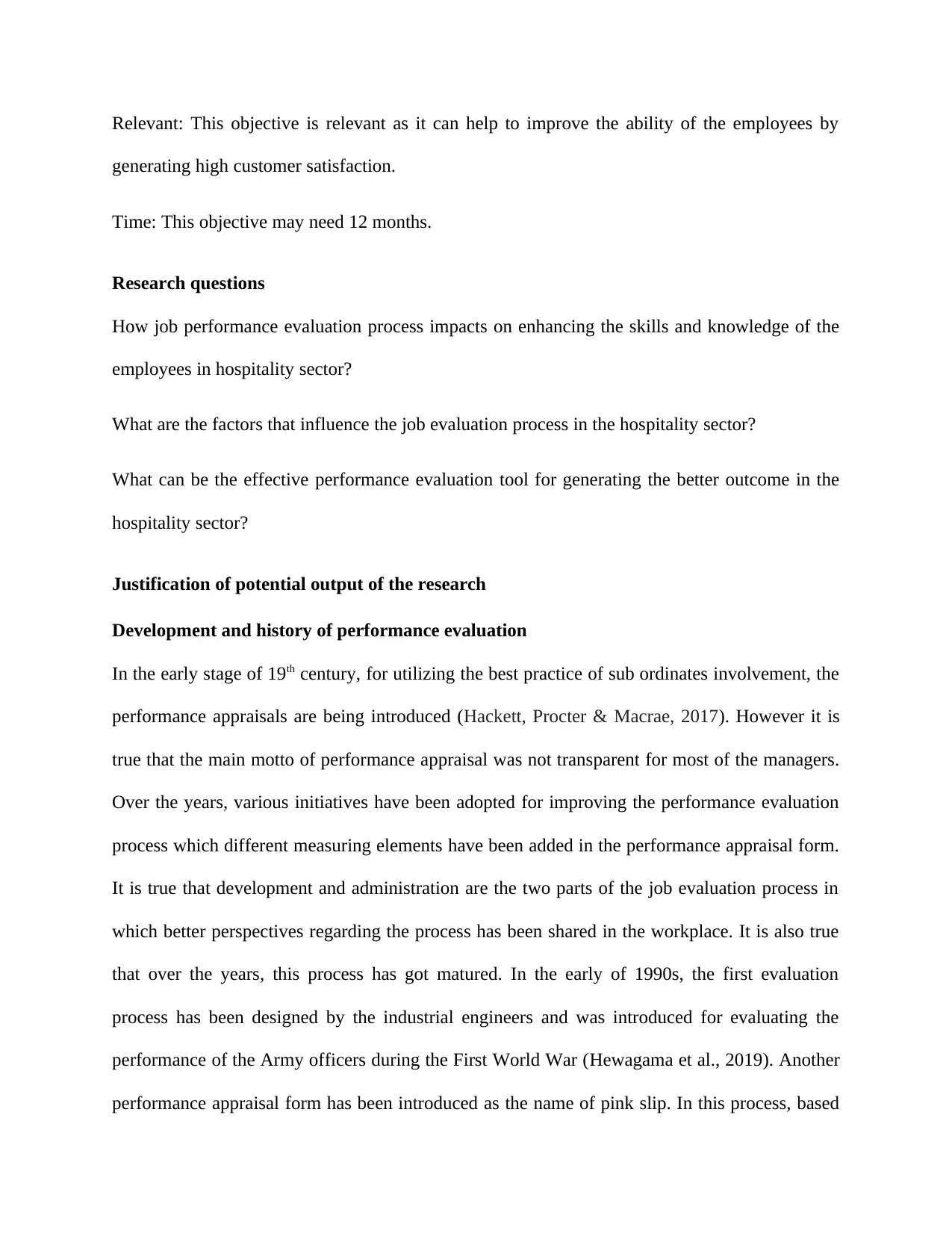
Relevant: This objective is relevant as it can help to improve the ability of the employees by
generating high customer satisfaction.
Time: This objective may need 12 months.
Research questions
How job performance evaluation process impacts on enhancing the skills and knowledge of the
employees in hospitality sector?
What are the factors that influence the job evaluation process in the hospitality sector?
What can be the effective performance evaluation tool for generating the better outcome in the
hospitality sector?
Justification of potential output of the research
Development and history of performance evaluation
In the early stage of 19th century, for utilizing the best practice of sub ordinates involvement, the
performance appraisals are being introduced (Hackett, Procter & Macrae, 2017). However it is
true that the main motto of performance appraisal was not transparent for most of the managers.
Over the years, various initiatives have been adopted for improving the performance evaluation
process which different measuring elements have been added in the performance appraisal form.
It is true that development and administration are the two parts of the job evaluation process in
which better perspectives regarding the process has been shared in the workplace. It is also true
that over the years, this process has got matured. In the early of 1990s, the first evaluation
process has been designed by the industrial engineers and was introduced for evaluating the
performance of the Army officers during the First World War (Hewagama et al., 2019). Another
performance appraisal form has been introduced as the name of pink slip. In this process, based
generating high customer satisfaction.
Time: This objective may need 12 months.
Research questions
How job performance evaluation process impacts on enhancing the skills and knowledge of the
employees in hospitality sector?
What are the factors that influence the job evaluation process in the hospitality sector?
What can be the effective performance evaluation tool for generating the better outcome in the
hospitality sector?
Justification of potential output of the research
Development and history of performance evaluation
In the early stage of 19th century, for utilizing the best practice of sub ordinates involvement, the
performance appraisals are being introduced (Hackett, Procter & Macrae, 2017). However it is
true that the main motto of performance appraisal was not transparent for most of the managers.
Over the years, various initiatives have been adopted for improving the performance evaluation
process which different measuring elements have been added in the performance appraisal form.
It is true that development and administration are the two parts of the job evaluation process in
which better perspectives regarding the process has been shared in the workplace. It is also true
that over the years, this process has got matured. In the early of 1990s, the first evaluation
process has been designed by the industrial engineers and was introduced for evaluating the
performance of the Army officers during the First World War (Hewagama et al., 2019). Another
performance appraisal form has been introduced as the name of pink slip. In this process, based
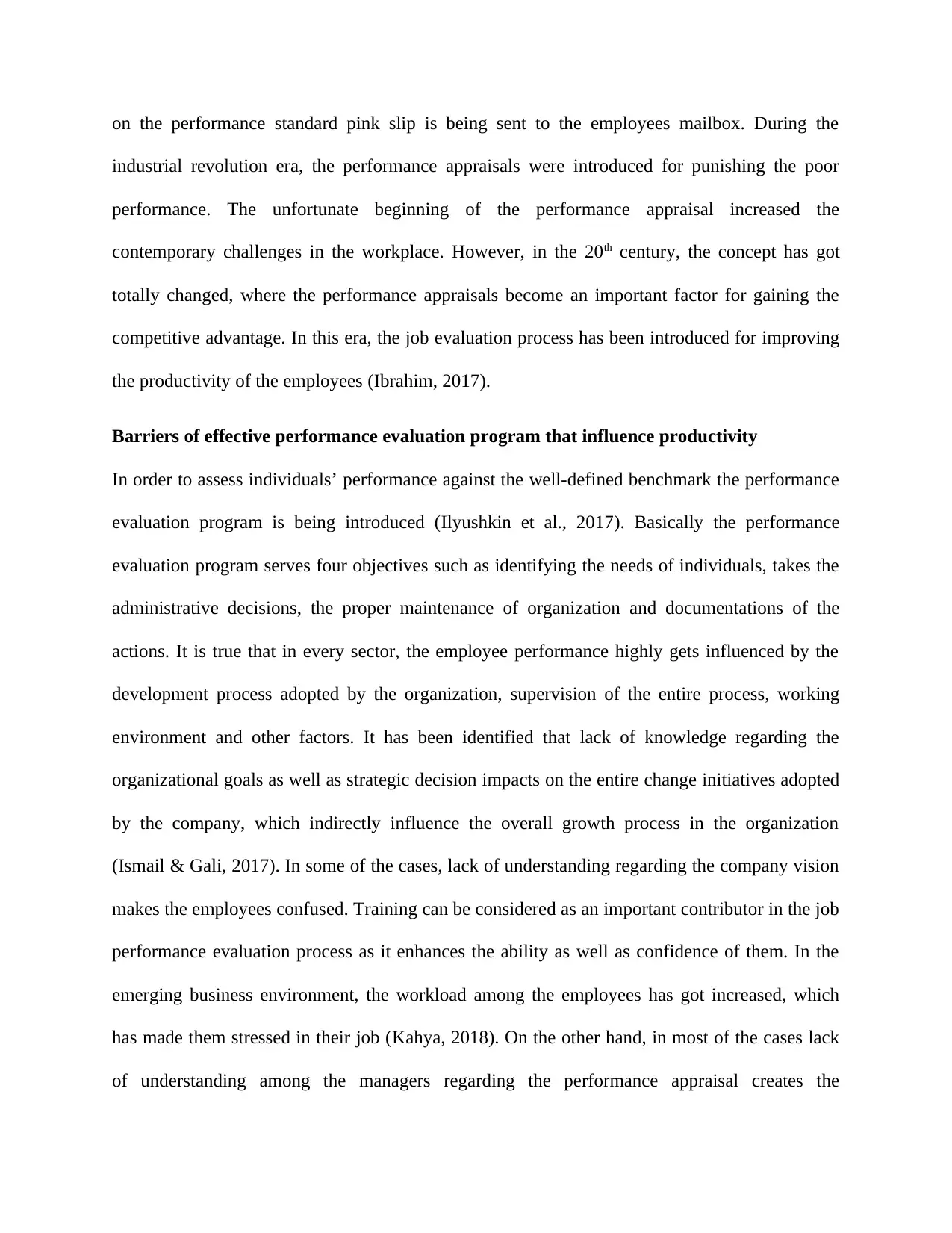
on the performance standard pink slip is being sent to the employees mailbox. During the
industrial revolution era, the performance appraisals were introduced for punishing the poor
performance. The unfortunate beginning of the performance appraisal increased the
contemporary challenges in the workplace. However, in the 20th century, the concept has got
totally changed, where the performance appraisals become an important factor for gaining the
competitive advantage. In this era, the job evaluation process has been introduced for improving
the productivity of the employees (Ibrahim, 2017).
Barriers of effective performance evaluation program that influence productivity
In order to assess individuals’ performance against the well-defined benchmark the performance
evaluation program is being introduced (Ilyushkin et al., 2017). Basically the performance
evaluation program serves four objectives such as identifying the needs of individuals, takes the
administrative decisions, the proper maintenance of organization and documentations of the
actions. It is true that in every sector, the employee performance highly gets influenced by the
development process adopted by the organization, supervision of the entire process, working
environment and other factors. It has been identified that lack of knowledge regarding the
organizational goals as well as strategic decision impacts on the entire change initiatives adopted
by the company, which indirectly influence the overall growth process in the organization
(Ismail & Gali, 2017). In some of the cases, lack of understanding regarding the company vision
makes the employees confused. Training can be considered as an important contributor in the job
performance evaluation process as it enhances the ability as well as confidence of them. In the
emerging business environment, the workload among the employees has got increased, which
has made them stressed in their job (Kahya, 2018). On the other hand, in most of the cases lack
of understanding among the managers regarding the performance appraisal creates the
industrial revolution era, the performance appraisals were introduced for punishing the poor
performance. The unfortunate beginning of the performance appraisal increased the
contemporary challenges in the workplace. However, in the 20th century, the concept has got
totally changed, where the performance appraisals become an important factor for gaining the
competitive advantage. In this era, the job evaluation process has been introduced for improving
the productivity of the employees (Ibrahim, 2017).
Barriers of effective performance evaluation program that influence productivity
In order to assess individuals’ performance against the well-defined benchmark the performance
evaluation program is being introduced (Ilyushkin et al., 2017). Basically the performance
evaluation program serves four objectives such as identifying the needs of individuals, takes the
administrative decisions, the proper maintenance of organization and documentations of the
actions. It is true that in every sector, the employee performance highly gets influenced by the
development process adopted by the organization, supervision of the entire process, working
environment and other factors. It has been identified that lack of knowledge regarding the
organizational goals as well as strategic decision impacts on the entire change initiatives adopted
by the company, which indirectly influence the overall growth process in the organization
(Ismail & Gali, 2017). In some of the cases, lack of understanding regarding the company vision
makes the employees confused. Training can be considered as an important contributor in the job
performance evaluation process as it enhances the ability as well as confidence of them. In the
emerging business environment, the workload among the employees has got increased, which
has made them stressed in their job (Kahya, 2018). On the other hand, in most of the cases lack
of understanding among the managers regarding the performance appraisal creates the
⊘ This is a preview!⊘
Do you want full access?
Subscribe today to unlock all pages.

Trusted by 1+ million students worldwide
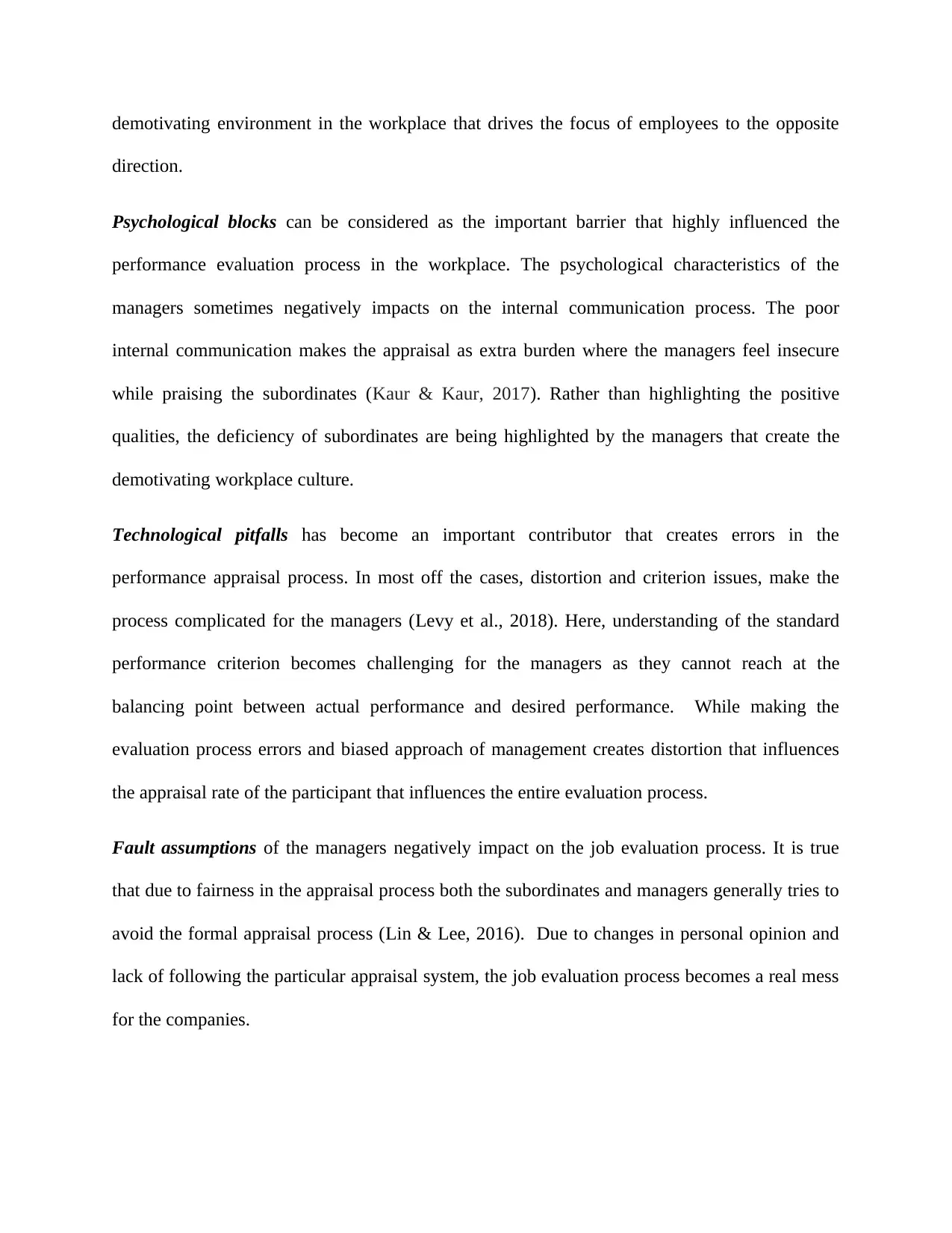
demotivating environment in the workplace that drives the focus of employees to the opposite
direction.
Psychological blocks can be considered as the important barrier that highly influenced the
performance evaluation process in the workplace. The psychological characteristics of the
managers sometimes negatively impacts on the internal communication process. The poor
internal communication makes the appraisal as extra burden where the managers feel insecure
while praising the subordinates (Kaur & Kaur, 2017). Rather than highlighting the positive
qualities, the deficiency of subordinates are being highlighted by the managers that create the
demotivating workplace culture.
Technological pitfalls has become an important contributor that creates errors in the
performance appraisal process. In most off the cases, distortion and criterion issues, make the
process complicated for the managers (Levy et al., 2018). Here, understanding of the standard
performance criterion becomes challenging for the managers as they cannot reach at the
balancing point between actual performance and desired performance. While making the
evaluation process errors and biased approach of management creates distortion that influences
the appraisal rate of the participant that influences the entire evaluation process.
Fault assumptions of the managers negatively impact on the job evaluation process. It is true
that due to fairness in the appraisal process both the subordinates and managers generally tries to
avoid the formal appraisal process (Lin & Lee, 2016). Due to changes in personal opinion and
lack of following the particular appraisal system, the job evaluation process becomes a real mess
for the companies.
direction.
Psychological blocks can be considered as the important barrier that highly influenced the
performance evaluation process in the workplace. The psychological characteristics of the
managers sometimes negatively impacts on the internal communication process. The poor
internal communication makes the appraisal as extra burden where the managers feel insecure
while praising the subordinates (Kaur & Kaur, 2017). Rather than highlighting the positive
qualities, the deficiency of subordinates are being highlighted by the managers that create the
demotivating workplace culture.
Technological pitfalls has become an important contributor that creates errors in the
performance appraisal process. In most off the cases, distortion and criterion issues, make the
process complicated for the managers (Levy et al., 2018). Here, understanding of the standard
performance criterion becomes challenging for the managers as they cannot reach at the
balancing point between actual performance and desired performance. While making the
evaluation process errors and biased approach of management creates distortion that influences
the appraisal rate of the participant that influences the entire evaluation process.
Fault assumptions of the managers negatively impact on the job evaluation process. It is true
that due to fairness in the appraisal process both the subordinates and managers generally tries to
avoid the formal appraisal process (Lin & Lee, 2016). Due to changes in personal opinion and
lack of following the particular appraisal system, the job evaluation process becomes a real mess
for the companies.
Paraphrase This Document
Need a fresh take? Get an instant paraphrase of this document with our AI Paraphraser
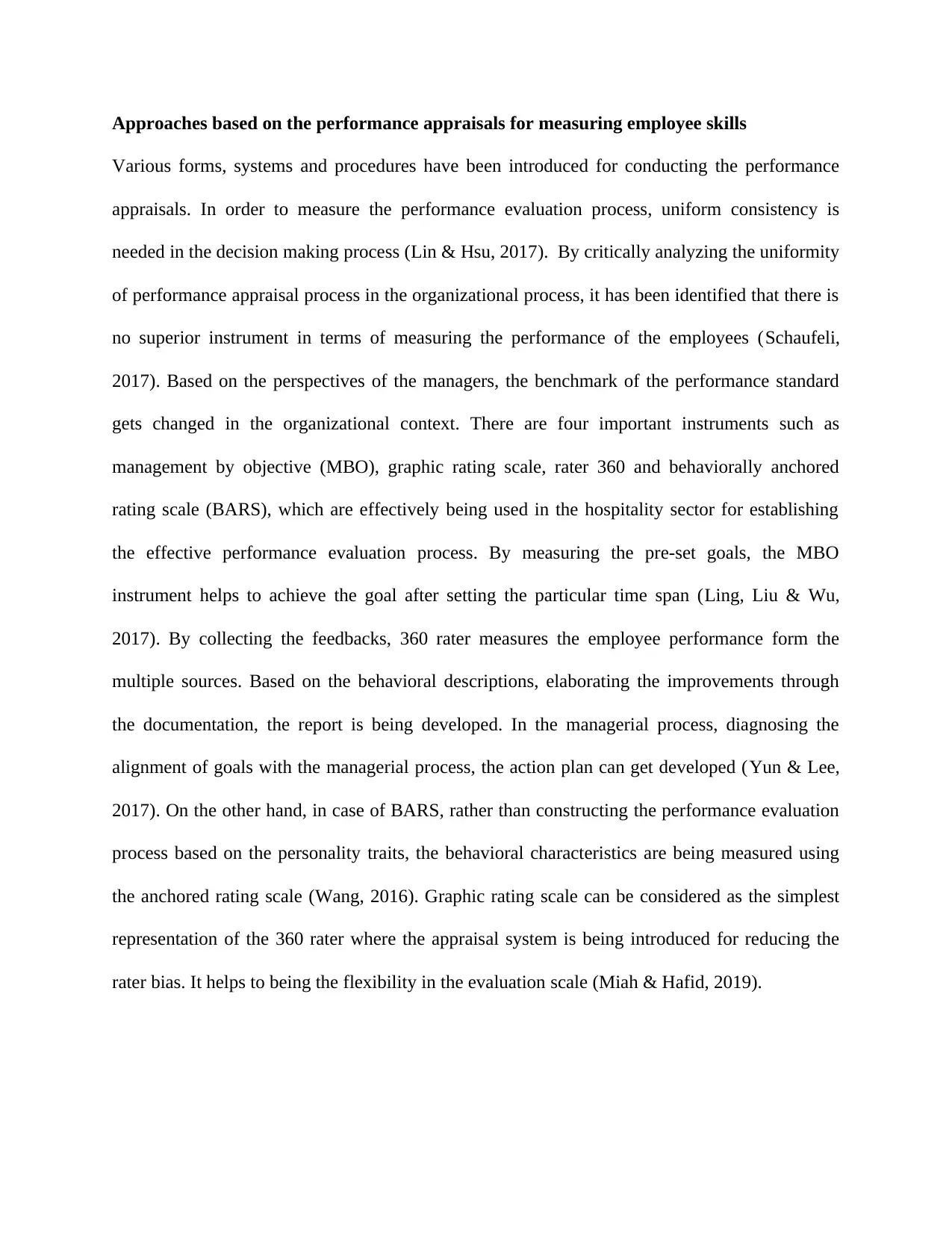
Approaches based on the performance appraisals for measuring employee skills
Various forms, systems and procedures have been introduced for conducting the performance
appraisals. In order to measure the performance evaluation process, uniform consistency is
needed in the decision making process (Lin & Hsu, 2017). By critically analyzing the uniformity
of performance appraisal process in the organizational process, it has been identified that there is
no superior instrument in terms of measuring the performance of the employees (Schaufeli,
2017). Based on the perspectives of the managers, the benchmark of the performance standard
gets changed in the organizational context. There are four important instruments such as
management by objective (MBO), graphic rating scale, rater 360 and behaviorally anchored
rating scale (BARS), which are effectively being used in the hospitality sector for establishing
the effective performance evaluation process. By measuring the pre-set goals, the MBO
instrument helps to achieve the goal after setting the particular time span (Ling, Liu & Wu,
2017). By collecting the feedbacks, 360 rater measures the employee performance form the
multiple sources. Based on the behavioral descriptions, elaborating the improvements through
the documentation, the report is being developed. In the managerial process, diagnosing the
alignment of goals with the managerial process, the action plan can get developed (Yun & Lee,
2017). On the other hand, in case of BARS, rather than constructing the performance evaluation
process based on the personality traits, the behavioral characteristics are being measured using
the anchored rating scale (Wang, 2016). Graphic rating scale can be considered as the simplest
representation of the 360 rater where the appraisal system is being introduced for reducing the
rater bias. It helps to being the flexibility in the evaluation scale (Miah & Hafid, 2019).
Various forms, systems and procedures have been introduced for conducting the performance
appraisals. In order to measure the performance evaluation process, uniform consistency is
needed in the decision making process (Lin & Hsu, 2017). By critically analyzing the uniformity
of performance appraisal process in the organizational process, it has been identified that there is
no superior instrument in terms of measuring the performance of the employees (Schaufeli,
2017). Based on the perspectives of the managers, the benchmark of the performance standard
gets changed in the organizational context. There are four important instruments such as
management by objective (MBO), graphic rating scale, rater 360 and behaviorally anchored
rating scale (BARS), which are effectively being used in the hospitality sector for establishing
the effective performance evaluation process. By measuring the pre-set goals, the MBO
instrument helps to achieve the goal after setting the particular time span (Ling, Liu & Wu,
2017). By collecting the feedbacks, 360 rater measures the employee performance form the
multiple sources. Based on the behavioral descriptions, elaborating the improvements through
the documentation, the report is being developed. In the managerial process, diagnosing the
alignment of goals with the managerial process, the action plan can get developed (Yun & Lee,
2017). On the other hand, in case of BARS, rather than constructing the performance evaluation
process based on the personality traits, the behavioral characteristics are being measured using
the anchored rating scale (Wang, 2016). Graphic rating scale can be considered as the simplest
representation of the 360 rater where the appraisal system is being introduced for reducing the
rater bias. It helps to being the flexibility in the evaluation scale (Miah & Hafid, 2019).
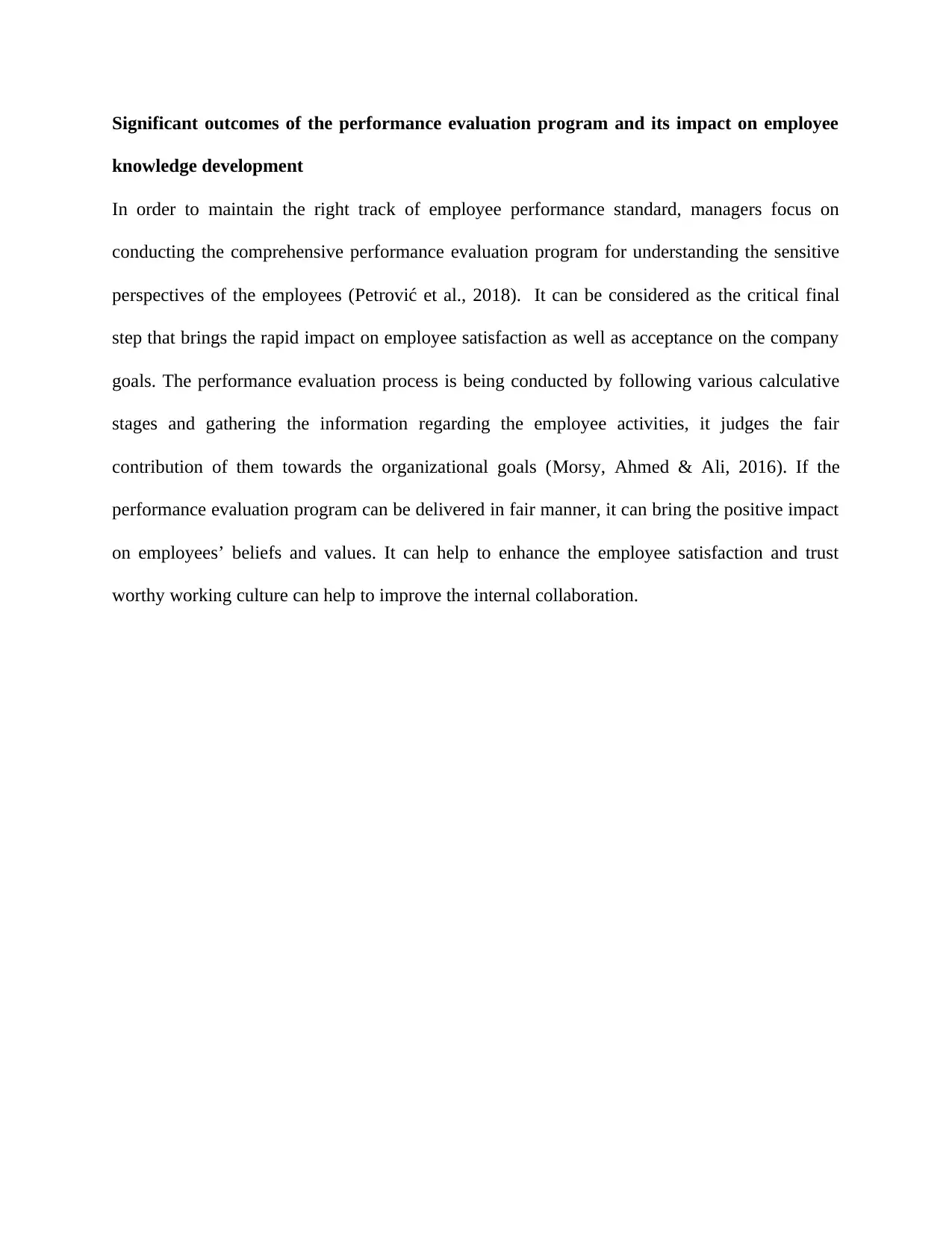
Significant outcomes of the performance evaluation program and its impact on employee
knowledge development
In order to maintain the right track of employee performance standard, managers focus on
conducting the comprehensive performance evaluation program for understanding the sensitive
perspectives of the employees (Petrović et al., 2018). It can be considered as the critical final
step that brings the rapid impact on employee satisfaction as well as acceptance on the company
goals. The performance evaluation process is being conducted by following various calculative
stages and gathering the information regarding the employee activities, it judges the fair
contribution of them towards the organizational goals (Morsy, Ahmed & Ali, 2016). If the
performance evaluation program can be delivered in fair manner, it can bring the positive impact
on employees’ beliefs and values. It can help to enhance the employee satisfaction and trust
worthy working culture can help to improve the internal collaboration.
knowledge development
In order to maintain the right track of employee performance standard, managers focus on
conducting the comprehensive performance evaluation program for understanding the sensitive
perspectives of the employees (Petrović et al., 2018). It can be considered as the critical final
step that brings the rapid impact on employee satisfaction as well as acceptance on the company
goals. The performance evaluation process is being conducted by following various calculative
stages and gathering the information regarding the employee activities, it judges the fair
contribution of them towards the organizational goals (Morsy, Ahmed & Ali, 2016). If the
performance evaluation program can be delivered in fair manner, it can bring the positive impact
on employees’ beliefs and values. It can help to enhance the employee satisfaction and trust
worthy working culture can help to improve the internal collaboration.
⊘ This is a preview!⊘
Do you want full access?
Subscribe today to unlock all pages.

Trusted by 1+ million students worldwide
1 out of 19
Related Documents
Your All-in-One AI-Powered Toolkit for Academic Success.
+13062052269
info@desklib.com
Available 24*7 on WhatsApp / Email
![[object Object]](/_next/static/media/star-bottom.7253800d.svg)
Unlock your academic potential
Copyright © 2020–2025 A2Z Services. All Rights Reserved. Developed and managed by ZUCOL.





